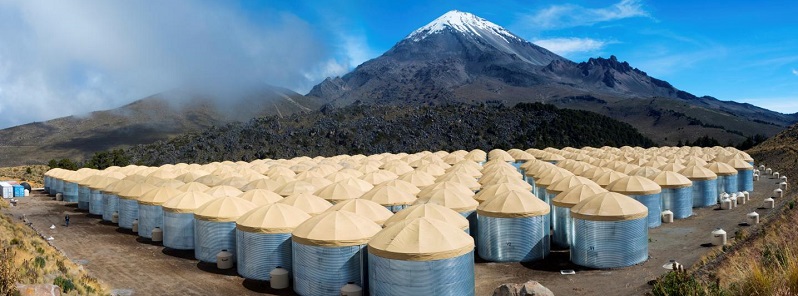Influx of Earth-bound positrons must have exotic origin, study suggests

The excess positrons arriving at Earth must have a more exotic origin than nearby pulsars, report researchers.
Their results are based on observations from the High-Altitude Water Cherenkov (HAWC) gamma-ray observatory in Mexico, which detects the shower of particles created when high-energy gamma rays smash into Earth's atmosphere. To date, several cosmic ray detectors have found more positrons arriving at Earth than expected.

An image of the HAWC detector consisting of 300 large (188 000 liters / 50k gallon) water tanks, each with 4 photodetectors. HAWC is located at an altitude of 4100 m above sea level inside the Parque Nacional Pico de Orizaba, in Mexico. This material relates to a paper that appeared in the 17 Nov. 2017, issue of Science, published by AAAS. The paper, by A.U. Abeysekara at University of Utah in Salt Lake City, UT, and colleagues was titled, 'Extended gamma-ray sources around pulsars constrain the origin of the positron flux at Earth.' Credit: Jordan A. Goodman
Previous research has suggested that pulsars are likely sources of these extra particles, and a handful of known pulsars are both sufficiently close and sufficiently old to be prime sources.
Now, A. U. Abeysekara and colleagues have used HAWC to observe two suitable pulsars, finding extended emission of gamma rays around them. Because the extended emission is generated by high-energy electrons and positrons, studying the properties of these emissions helped the researchers calculate how far positrons generated by the pulsars could diffuse through space.
Their results demonstrate that positrons generated by these pulsars are not able to reach all the way to Earth.
The excess positrons arriving at our planet must have a more exotic origin, the authors say – perhaps due to annihilation or decay of dark matter particles, among other possibilities.
Provided by American Association for Advancement of Science
Featured image: An image of the HAWC detector consisting of 300 large (188 000 liters / 50k gallon) water tanks, each with 4 photodetectors. Credit: Jordan A. Goodman

It is necessary to know the way of forming celestial bodies and the order of the process of their creation. When forming matter from the substance Aether, which fills the infinite universe, quark gluon plasma is first formed and magnetars are filled out. In their further arrangement and transformation, quasars, pulsars and neutron stars are formed. The quasars and pulsars transmit from their surface different waves of particles that can contain neutrons. In the breakdown of neutrons, free gluons can also produce electrons and positrons, the residual-quarks, can be transformed into neutrons. Kd these transformations also occur photons. When a neutron star falls apart, that is, supernovae, clouds of gases forming stellar systems (solar systems) are formed and this takes place until the formation of clusters of galaxies, in which critical mass can form, when black holes are formed in the matter is returned to them in the form of Aether from which matter forms.